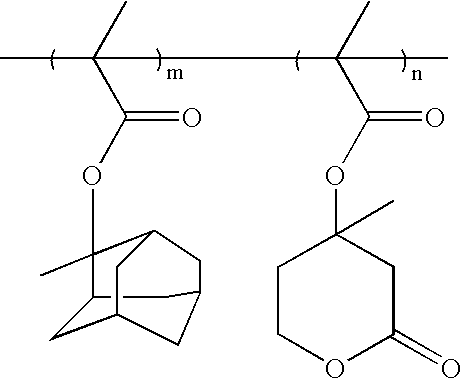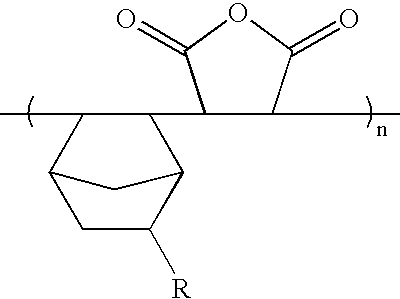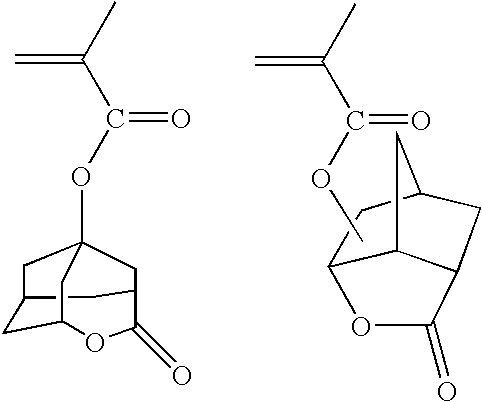Resist composition comprising photosensitive polymer having lactone in its backbone
a polymer and lactone technology, applied in the field of resist compositions, can solve the problems of resist materials suitable for use with arf eximer lasers suffering from a variety of drawbacks, increasing density and complexity of semiconductor devices, and increasing complexity, so as to improve the adhesion to the underlying material layer, improve the adhesion, and reduce the cost
- Summary
- Abstract
- Description
- Claims
- Application Information
AI Technical Summary
Benefits of technology
Problems solved by technology
Method used
Image
Examples
synthesis example 1
Synthesis of Terpolymer
[0081]
synthesis example 1-1
[0082](R3=methyl, R4=2-methyl-adamantyl)
[0083]12.0 g 2-methyladamantylmethacrylate (MAdMA), 3.4 g maleic anhydride (MA), and 1.66 g α-angelicalactone (AGL) were dissolved in 17 g tetrahydrofuran (THF). 1.38 g dimethyl 2,2′-azobisisobutyrate (V601) was added to the solution, degassed and polymerized at 70° C. for 20 hours.
[0084]After the reaction was completed, the obtained reaction product was precipitated with excess isopropyl alcohol twice, filtered, and dried in a vacuum oven for 24 hours, so that the terpolymer having the formula above was obtained with a yield of 72%.
[0085]The obtained terpolymer had a weight average molecular weight (Mw) of 11,400, and a polydispersity (Mw / Mn) of 2.4.
[0086]In the synthesis of the terpolymer, the mixing ratio of the monomers can be varied to adjust the solubility of the polymer. The various mixing ratios of the monomers and the characteristics of the resultant five terpolymers are listed below in Table 1.
[0087]
TABLE 1Mixing RatioCon-Solvent-of ...
synthesis example 1-2
[0088](R3=methyl, R4=8-ethyl-8-tricyclo[5.2.1.02,6]decanyl])
[0089]14.8 g 8-ethyl-8-tricyclo[5.2.1.02,6]decanylmethacrylate (ETCDMA), 3.4 g maleic anhydride (MA), and 1.66 g α-angelicalactone (AGL) were dissolved in 20 g tetrahydrofuran (THF). 1.38 g dimethyl 2,2′-azobisisobutyrate (V601) was added into the solution, degassed and polymerized at 70° C. for 20 hours.
[0090]After the reaction was completed, the obtained reaction product was precipitated with excess isopropyl alcohol twice, filtered, and dried in a vacuum oven for 24 hours, so that the terpolymer having the formula above was obtained with a yield of 65%.
[0091]The obtained terpolymer had a weight average molecular weight (Mw) of 12,100, and a polydispersity (Mw / Mn) of 2.6.
PUM
| Property | Measurement | Unit |
|---|---|---|
| size | aaaaa | aaaaa |
| glass transition temperature | aaaaa | aaaaa |
| polydispersity | aaaaa | aaaaa |
Abstract
Description
Claims
Application Information
 Login to View More
Login to View More - R&D
- Intellectual Property
- Life Sciences
- Materials
- Tech Scout
- Unparalleled Data Quality
- Higher Quality Content
- 60% Fewer Hallucinations
Browse by: Latest US Patents, China's latest patents, Technical Efficacy Thesaurus, Application Domain, Technology Topic, Popular Technical Reports.
© 2025 PatSnap. All rights reserved.Legal|Privacy policy|Modern Slavery Act Transparency Statement|Sitemap|About US| Contact US: help@patsnap.com



